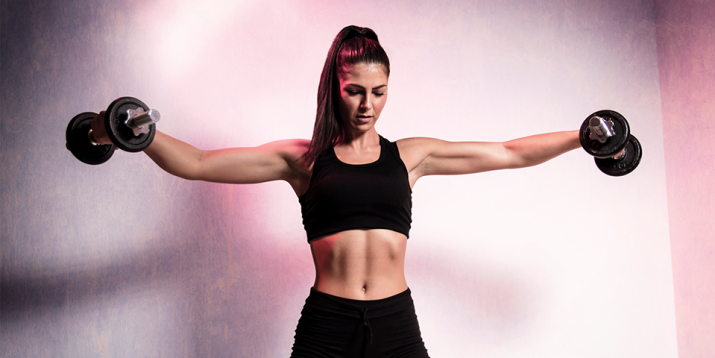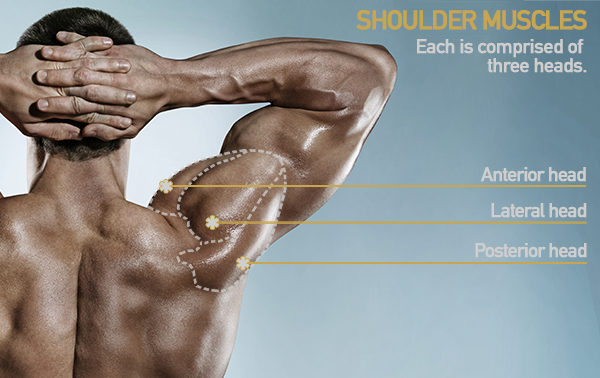14 Best Shoulder Exercises You Can Do at Home

Your shoulders are two of the most versatile joints in your body, capable of the greatest range of motion.
“But that unparalleled mobility also makes them vulnerable to injury,” explains Trevor Thieme, C.S.C.S.
That’s why it’s so important to actively strengthen the muscles supporting this joint by regularly performing shoulder workouts. To help you get started, we’ve pulled together some of the best moves — all you need is a pair of weights or a resistance band.
1. Military Press
Benefits: This moves targets the entire deltoid muscle and is excellent for muscle growth, Kelley says. It also works your triceps, traps, and pectoral muscles.
- Adjust an incline bench so the back is vertical and sit on the seat, holding two heavy dumbbells at shoulder height, palms facing forward.
- Keeping your back straight and core engaged, slowly press the dumbbells upward until your arms are straight.
- Lower your hands back to your shoulders and repeat.
2. Arnold Press
Benefits: This dumbbell exercise works both the middle and anterior parts of the deltoid, Kelley says. The rotational movement is also great for improving shoulder stability.
- Stand tall with your feet hip-width apart, holding a dumbbell in each hand.
- Engage your core. Keeping your back flat, bring your weights to shoulder level, with your forearms in front of your chest and your palms facing back. This is the starting position.
- Rotate the weights so that your palms face forward as you press the weights directly above your shoulders.
- Slowly lower the weights back to the starting position, and repeat for reps.
3. Dumbbell Lateral Raise
Benefits: This move is an excellent way to target your middle deltoid, Kelley says.
- Stand tall with your feet hip-width apart and your arms at your side, holding a dumbbell in each hand.
- Raise your arms to your sides until they’re level with your shoulders. Keep your palms facing downward.
- Slowly lower your arms, and repeat for reps.
4. Front Deltoid Raise
Benefits: This move best isolates the anterior (frontal) head of the shoulder muscle.
- Stand with your feet hip-width apart, holding a pair of dumbbells at your sides.
- Keeping your arms straight, slowly lift the weights up directly in front of you to shoulder height with your palms facing each other.
- Lower back down to the starting position and repeat for reps.
5. Dumbbell Bent-Over Row
Benefits: The bent-over row targets the rear head of your deltoids in concert with the muscles of your upper back.
- Stand with your feet hip-width apart holding a pair of dumbbells at your sides.
- Engaging your core, push your hips back and hinge forward at your waist until your torso is almost parallel with the floor. Let your arms hang straight down, with your palms facing each other.
- Keeping your back flat, and squeeze your shoulder blades together as you pull the weights up to your sides.
- Pause, then lower the weights to the starting position. Repeat for the prescribed number of reps.
6. Reverse Fly
Benefits: Although primarily an upper back exercise, this move also engages the posterior deltoid, Kelly says.
- Stand with your feet shoulder-width apart, holding a dumbbell in each hand.
- Bend forward at the hips until your chest is almost parallel with the ground. Allow the weights to hang straight down at arm’s length, palms facing each other. This is the starting position.
- Keeping your back flat, raise your arms out to your sides until they’re in line with your body. Squeeze your shoulder blades together at the top of the movement.
- Return to the starting position, and repeat for reps.
7. Plank Raise Tap Crunch

Benefits: “This bodyweight move is another good closed-chain exercise for shoulder stability,” Miami-based physical therapist William P. Kelley, CSCS, ACT, says. The plank crunch part of the move is also great for working your core.
- Start in a straight arm plank position with your shoulders stacked above your hands and your feet hip-width apart.
- Extend your right arm forward, then place it back down into the plank.
- Extend your right arm to the side, then place it back down into the plank.
- Keep your body in a straight line as you reach your opposite (left) arm under your body, pull your right leg toward your core, and tap your right foot with your left hand.
- Return to the plank position.
- Do all of your reps, and then repeat on your opposite side.
8. Deep Swimmer’s Press

Benefits: This move works the shoulder through an even greater range of motion than a conventional overhead press, placing emphasis on the deltoid’s frontal head.
- Stand tall with your feet hip-width apart, holding a pair of dumbbells at your sides, palms facing forward.
- Keeping your elbows close to your sides, curl the dumbbells up until your elbows are bent at 90 degrees. This is the starting position.
- Curl the weights up toward your shoulders, then press them overhead, rotating your hands so your palms face forward as you reach the top of the movement.
- Reverse the movement, lowering the weights as you rotate your palms back toward your body, and finishing in the half-curl, palms-up, starting position. Repeat for reps.
9. Sit-Through
Benefits: This bodyweight exercise hits all three heads of the deltoid as you transition through it.
- Assume a bear stance with your arms straight, your hands below your shoulders, and your knees bent 90 degrees below your hips. (Only your hands and toes should touch the floor.)
- Keeping your back flat, core engaged, and right hand on the floor, lift your left arm and right leg, and open your body to the left, pivoting on your left foot as you thread your right leg beneath you and extend it straight on the floor.
- Reverse the movement to return to the starting position. Repeat on the other side, lifting your right hand and left leg, and pivoting on your right foot.
- Continue alternating sides for reps.
10. Callahan Press
Benefits: The Callahan press — a variation on the traditional shoulder press — is a good way to challenge your rotator cuff musculature, Kelley says.
- Holding a dumbbell in each hand, assume a staggered stance and raise your arms out to your sides with your elbows bent 90 degrees. Your upper arms should be in line with your shoulders, and your hands should point toward the ceiling. This is the starting position.
- Bring your forearms together in front of you, and then reverse the movement to return to the starting position.
- Press the weights directly above your shoulders, and then reverse the movement to return to the starting position. That’s one rep.
11. Diving Dolphin
Appears in: P90 – Sculpt C
Benefits: This engages your anterior deltoids without any equipment. Kelley explains that it’s also great for enhancing shoulder stability, since it utilizes the shoulders in a closed-chain movement, meaning your hands and feet are in a fixed position throughout the exercise.
- Start in a forearm plank with your elbows under your shoulders and your feet hip-width apart.
- Walk your feet in towards your arms about eight to 12 inches so your hips are lifted slightly toward the ceiling. This is the starting position.
- Lower your hips and keep your body in a straight line as you drive your shoulders forward to hover over your wrists.
- Reverse the movement to return to the starting position, and repeat.
12. Clean Squat Press
Appears in: 22 Minute Hard Corps – Special Ops: Resistance
Benefits: A slightly more complicated, but very effective move, the clean squat press is a total-body exercise. “It’s especially good for the shoulder because it allows you to safely use momentum to power through some extra reps,” says Kelley.
- Stand with your feet hip-width apart and your arms at your sides, holding a dumbbell in each hand.
- Lower into a squat, keeping your arms at your sides.
- Simultaneously stand up and curl the weights from the hanging position to the “clean” position (shoulder-height with your palms facing each other).
- Without pausing, drop back into a squat, and then stand up as you press the weights directly above your shoulders.
- Lower the weights back down to your sides as you lower your body back into a squat.
- Continue repeating the entire sequence.
13. Scarecrow Press
Appears in: P90 – Sculpt B
Benefits: The scarecrow press — a variation on the traditional shoulder press — is a good way to challenge your rotator cuff musculature, Kelley says.
- Holding a dumbbell in each hand, assume a staggered stance and raise your arms out to your sides with your elbows bent 90 degrees. Your upper arms should be in line with your shoulders, and your hands should point toward the ceiling. This is the starting position.
- Bring your forearms together in front of you, and then reverse the movement to return to the starting position.
- Press the weights directly above your shoulders, and then reverse the movement to return to the starting position. That’s one rep.
14. Alternating Lunge With Lateral and Front Raise
Appears in: Shift Shop – Strength: 35 (as “Flying Lunges”)
Benefits: This compound move is a killer total-body exercise, Kelley says. The lateral raise targets your lateral deltoids and your traps while the front raise targets your anterior deltoids. You’ll also be working your core and hammering your quads and glutes as you rotate and lunge.
- Stand with your feet shoulder-width apart and your arms at your sides, holding a dumbbell in each hand.
- Keeping your back flat and your core engaged, raise your arms straight in front of your chest, palms facing each other.
- Lower your arms, pivot to your left, and lower yourself into a lunge position (rear knee bent 90 degrees, front thigh parallel to the floor) as you raise your arms straight out to your sides, palms facing down.
- Lower the weights as you stand back up, and then pivot back to center to return to the starting position.
- Repeat the entire sequence, this time pivoting to your right.
- Continue alternating sides.
How and When to Do Shoulder Workouts
Kelley recommends doing targeted shoulder workouts twice a week, and spreading them out so your muscles have a chance to rest. You can work out your shoulders more often, but keep in mind that they’ll also be engaged during many chest, back, and arm exercises, and even HIIT or Pilates, Kelley says.
If you want to specifically increase shoulder size, you need to perform movements that employ multiple angles to hit each part of the deltoids. The best shoulder workouts will include a variety of moves to work your rotator cuff and deltoid muscles so you can build strength, stability, and mass.
Shoulder Anatomy
Before you dive into a shoulder workout, it’s helpful to understand the different parts of the shoulder muscle.

There are two layers of musculature to the shoulder: the rotator cuff and the deltoids. Both parts of the shoulder are important, but they serve different functions.
“The muscles that stabilize each joint are those of the rotator cuff — the supraspinatus, infraspinatus, teres minor, and subscapularis,” Thieme explains. “But it’s the deltoids — the muscles on top of the rotator cuffs — that give shoulders their shape and drive most shoulder movements.”
There are three parts of each deltoid — the anterior (front), lateral (middle), and posterior (back).
